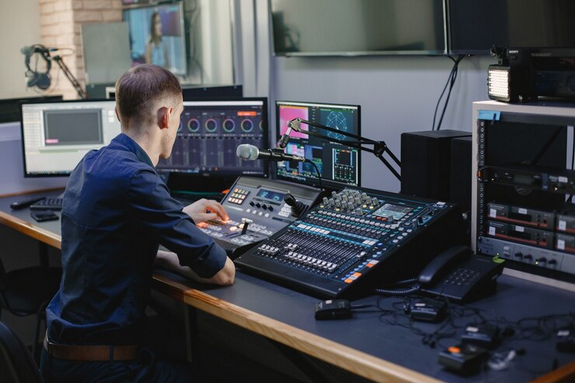In the intricate world of audiovisual systems design, the marriage of art and science is a delicate dance. This guide aims to unravel the complexities involved in mastering the mix, shedding light on the multifaceted nature of crafting seamless and immersive audiovisual experiences.
The Intersection of Art and Science in AV Systems Design
Audiovisual (AV) systems design is a dynamic field that demands a synthesis of artistic creativity and scientific precision. It goes beyond the mere selection of equipment and involves an in-depth understanding of how audio and visual elements interact within a given space. The art lies in creating an emotionally resonant experience, while the science ensures technical reliability and optimal performance.
Designing the perfect mix requires a nuanced approach. Consultants must consider the aesthetics of the space, the intended emotional impact, and the technical specifications of the audiovisual components. This intersection of art and science is where the true mastery of AV systems design unfolds.
Aesthetic Considerations in Design
The visual aspect of AV systems design is a canvas waiting to be painted with light, color, and form. Design consultants begin by understanding the overarching aesthetic goals of the project. Whether it's a corporate boardroom, a concert hall, or a museum exhibit, the design must align with the visual language and atmosphere desired by the client.
This involves considerations such as architectural elements, interior design, and the integration of visual technologies. The placement of displays, the choice of lighting fixtures, and the overall spatial layout contribute to the visual aesthetics of the space. The challenge is to seamlessly integrate these elements, ensuring they enhance rather than detract from the overall experience.
Acoustic Engineering and Soundscapes
While the visual components are crucial, the auditory dimension is equally vital in mastering the mix. Acoustic engineering plays a pivotal role in creating immersive soundscapes that complement the visual experience. Consultants delve into the science of sound propagation, absorption, and reflection to optimize the acoustics of a space.
Considerations such as speaker placement, room dimensions, and sound isolation are meticulously addressed. The goal is to achieve a balanced and enveloping auditory experience that enhances the overall impact of the AV system. This scientific approach ensures that every note, dialogue, or sound effect is delivered with clarity and precision.
Technical Specifications and Integration
The backbone of AV systems design lies in the technical specifications of the components and their seamless integration. Design consultants act as orchestrators, selecting the right mix of audio and visual equipment to achieve the desired outcome. This involves understanding the capabilities of various technologies, considering factors such as resolution, brightness, and audio fidelity.
The integration process requires a deep understanding of compatibility and connectivity. Different components must communicate flawlessly to create a cohesive system. The technical intricacies extend to control interfaces, network integration, and the implementation of cutting-edge technologies. The artistry lies in making these technical components invisible to the end-user, allowing them to immerse themselves fully in the experience.
Human-Centric Design and User Experience
At the heart of mastering the mix is a focus on human-centric design. The success of an AV system is ultimately measured by the user experience it delivers. Design consultants take into account the needs and preferences of the end-users, ensuring that the system is intuitive and user-friendly.
This involves the design of user interfaces, control systems, and interactive elements. The placement of controls, the clarity of instructions, and the overall ease of operation contribute to a positive user experience. The art and science converge in creating a design that not only functions seamlessly but also enhances the overall enjoyment for the end-user.
Testing and Calibration for Precision
The journey to mastering the mix involves rigorous testing and calibration. Scientific measurements are employed to ensure that the audio and visual components perform with precision. This phase involves fine-tuning parameters such as color balance, audio levels, and alignment of visual displays.
Testing is not only confined to controlled environments but extends to real-world scenarios. Design consultants simulate the conditions under which the AV system will operate, considering variables such as ambient light, audience size, and acoustic characteristics of the space. This meticulous approach ensures that the design translates seamlessly from theory to practice.
Adaptability and Future-Proofing
In the ever-evolving landscape of technology, adaptability is a key consideration in mastering the mix. Design consultants anticipate future advancements and ensure that the AV system is equipped to embrace emerging technologies. This involves selecting components with upgradeable firmware, future-proofing the infrastructure for evolving standards, and staying abreast of industry trends.
The art lies in creating a design that stands the test of time, remaining relevant and cutting-edge despite the rapid pace of technological innovation. The science ensures that the design is flexible enough to accommodate changes and upgrades without compromising the integrity of the system.
Conclusion
In conclusion, mastering the mix in audiovisual systems design is a delicate blend of artistry and scientific precision. The interplay between visual aesthetics, acoustic engineering, technical specifications, human-centric design, testing, and adaptability defines the mastery of AV systems design. It is a dynamic field where the convergence of art and science creates immersive and impactful audiovisual experiences.
As technology continues to advance, the role of design consultants becomes increasingly crucial in shaping the future of AV systems. The mastery lies not only in the flawless execution of a design but in the ability to evoke emotions, tell stories, and transport audiences through the seamless integration of audio and visual elements. The art and science of audiovisual systems design are inextricably linked, and it is within this intersection that the true magic of mastering the mix unfolds.





Comments